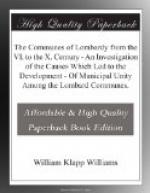[12:] Geschichte des roemischen Rechts im Mittelalter, passim.
[13:] Brunetti: Cod. Diplom. Toscan. Firenze, 1806, Docum. No. 44.
[14:] Idem. Docum. No. 8.
[15:] Brunetti: Cod. Diplom. Toscan. Docum. Nos. 6-10.
[16:] Idem. Docum. No. 43.
[17:] Liutprandi: Leg. Long. Prolog. Anni XVI. et XV. et al. Vid. Muratori: Script. Rer. Ital., Tom. I., P. II., p. 15, et seq.
[18:] Liutprandi: Leg. Prolog. Anni XIII. Vid. Muratori: Script. Rer. Ital., Tom. I., P. II., p. 15.
[19:] Crimoaldi: Leg. Prolog. Vid. Muratori op. cit. Tom. I., P. II., p. 49.
[20:] Liutprandi: Leg. Prolog. ad Lib. III. Vid. Muratori: Script. Rer. Ital., Tom. I., Pars II., p. 15.
[21:] Muratori: Script. Rer. Ital., T. II., Pars II.
[22:] Savigny: Gesch. des roem. Rechts im Mittelalter, S. 422 et al.
[23:] Muratori: Script. Rer. Ital., Tom. I., Pars II., p. 15.
[24:] Paulus Diaconus: De Gest. Langobard., Lib. III., cap. 16.
[25:] Brunetti: Cod. Diplom. Toscan. Docum. No. 6, anni 715.
[26:] Ibid.: Cod. Diplom. Toscan. Docum. No. 8, anni 715.
[27:] Ibid.: Docum. No. 11, anni 716.
[28:] Ibid.: Docum. No. 50, anni 756.
[29:] Muratori: Script. Rer. Ital., Tom. I., Pars II., p. 192E.
[30:] Muratori: Antiq. Ital. Diss. II., p. 186.
[31:] Muratori: Script. Rer. Ital., Tom. II., Pars II., p. 409.
[32:] In a donation to “Aimo Voltarius, abitator castrii Viterbii.” Vid, Troya: Della Condizione, etc., p. 361. Docum. No. 6, anni 775.
[33:] Ughelli: Italia Sacra, Tom. III., p. 28.
[34:] Ibid.: Tom. II., p. 145.
[35:] The word palatium in the signification of fiscus is perhaps more frequently used by the Frankish kings than by the Lombard. See a privilegium granted to the nuns of the Posterla di Pavia by Lothar I. in the year 839, in which it appears that any one infringing its privileges must pay seventy pounds of the best gold, to be applied “medietatem Palatio nostro, et medietatem parti ejusdem monasterii.” Vid. Muratori: Antiq. Ital. Diss. XVI., Tom I., P. I., p. 233. Also several diplomas of Charles the Fat, and others make use of the same term. The word camera for fiscus as the imperial treasury, was probably not used before the time of Lewis II.; the first authentic use of it in that sense being probably a diploma of that monarch of the year 894, where he says that one hundred pounds of gold are to be paid “medietatem Imperiali Camere et medietatem suprataxatae Angilberge.” Vid. Muratori: loc. cit. p. 234.




